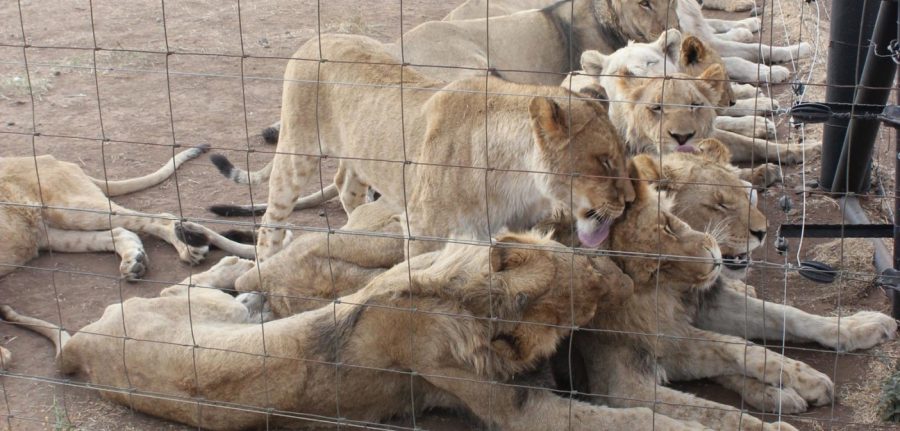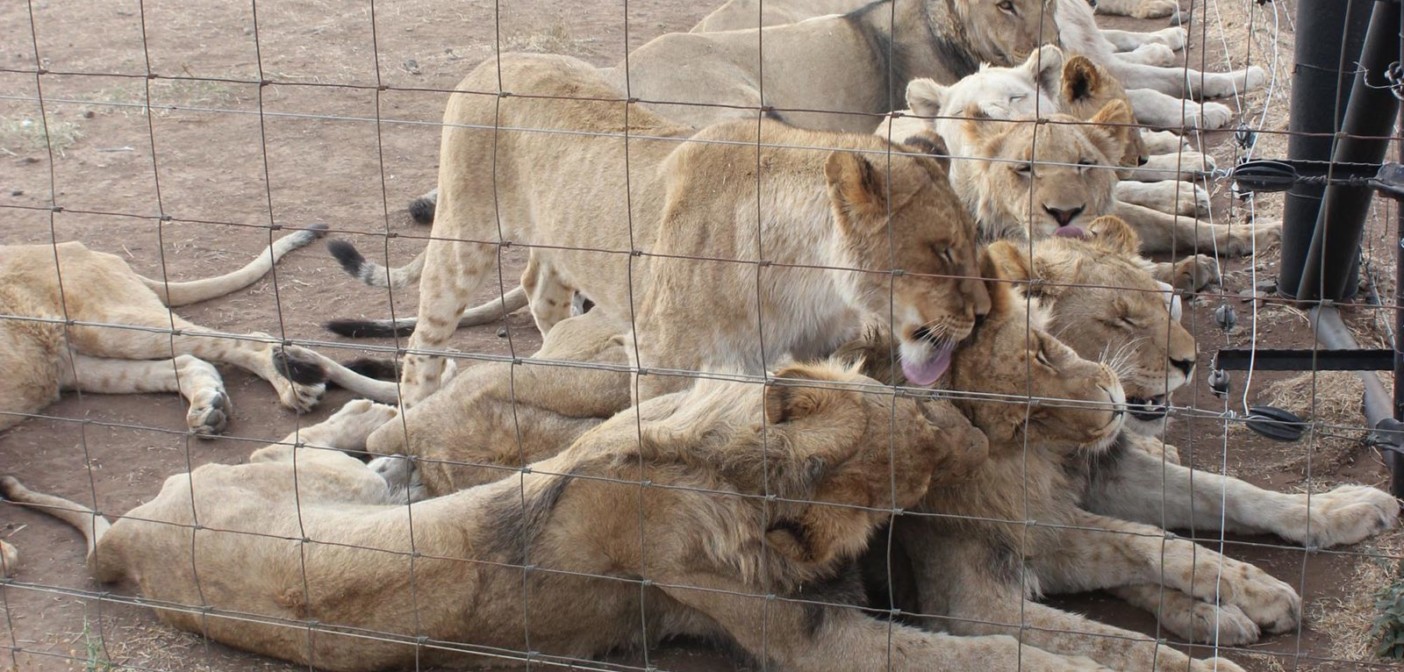
South Africa Reclassifies 33 Wild Species (Lions, Rhinos…) as FARM Animals
By the stroke of a legislative pen, a list of iconic and in some cases endangered wild animals can now be manipulated as farming stock. What happens next is anyone’s guess… writes Don Pinnock. Lions, cheetahs, rhinos and zebras were among 33 wild species which became farm animals as of May this year when the […]

By the stroke of a legislative pen, a list of iconic and in some cases endangered wild animals can now be manipulated as farming stock. What happens next is anyone’s guess… writes Don Pinnock.

Lions, cheetahs, rhinos and zebras were among 33 wild species which became farm animals as of May this year when the South African Government approved a brief amendment to the Animal Improvement Act (AIA) which governs livestock breeding.
There has been virtually no mention of this in the media, as the legislation was slipped through without public consultation. There’s no international precedent for such an extraordinary “domestication” of wild animals.
This act permits “improvement” of “genetically superior” animals to “increase production or performance” by licensed animal breeders. It states “different kinds of animals or breeds of such kinds of animals may be so declared,” but it is unlikely, at the time the legislation was promulgated in 1998, that such a declaration would include wild and especially endangered and iconic species.
AIA permits “animal breeder societies” to manipulate breeding outcomes in the way we have altered aurochs into docile cows, the grey wolf into the many breeds of dogs and produced “golden” impala. Most of these breeds can no longer survive in the wild.
The list includes Cape buffalos, mountain zebras, lions, giraffe, white and black rhinos, cheetahs, a large number of plains game in addition to curiosities like ankole cattle, water buffaloes, Tankwa and veld goats, bulldogs, keeshonds, pugs and rottweilers.
The legislation allows artificial insemination, the collection of semen and embryos as well as the transfer of embryos and “genetic material.” Such material can be collected, evaluated, processed, packed and sold. Though this is common practice with traditional farm animals, it carries considerable risks for wild ones.
The Department of Environment Forestry and Fisheries (DEFF) advised that the amendment was made “due to changing farming systems in South Africa, game animals are included as these are already part of farm animal production systems in the country”.
When it was questioned by the Democratic Alliance in Parliament, a written reply stated no public participation process to such an amendment was required and that it followed a 2017 request “from the industry” to facilitate game farming production.
It defined this industry as representing “game breeder societies” whose role was “to ensure genetic purity and sustainable utilisation; do research on feeding and nutrition; define and measure traits of economic importance; and study regulatory gaps on game for food production”.
According to NSPCA director Karen Trendler, there has been a strong lobby from the wildlife industry to have control of wildlife breeding moved to agriculture, which she says has many worrying implications.
“The problems associated with semi-intensive and intensive farming are well known,” she said, “such as increased occurrence of disease and increased need for routine use of antibiotics and growth promotants, vaccinations” and so on.
In response to a comment in Farmer’s Weekly saying game listed under the amendment would no longer be protected by conservation legislation, DEFF issued a statement saying they would still be subject to requirements of the National Environmental Management: Biodiversity Act (NEMBA).
However, NEMBA actually offers very little protection against exploitation. It forbids hybridisation between different species and states that permits to keep or utilise animals would be revoked if treatment is “detrimental”, but does not specify what is meant by this. It has no provision for the welfare of individual animals. The act deals mainly with licencing of commercial use of listed or threatened species.
The National Environmental Management Laws Amendment Bill, presently under review, appears to slightly increase protection, stating that the minister may “prohibit acts that impact negatively on well-being of a faunal biological resource”. Well-being, not being defined in the bill, could mean almost anything. This also means that a wild animal would only be protected in terms of its value as a human resource and not for its own sake.
So this raises the question: if the AIA amendment is not for the protection of the 33 wild animals that now fall under the act, what was behind the request from “the industry”? A clue might be in the permit restrictions and constraints imposed by NEMBA on the hunting and particularly the movement of listed and protected animals.
The act requires strict control over conveying, moving or otherwise translocating any specimen of a threatened or protected species, as well as “selling or otherwise trading in, buying, receiving, giving, donating or accepting as a gift, or in any way acquiring or disposing of any specimen of a listed threatened or protected species”. The AIA has none of these restrictions in pursuit of “improved” stock.
So does the amendment tighten or loosen the control of farmed wildlife? It’s a grey area within which violations of animal welfare could flourish.
Although the amendment has undoubtedly been celebrated by the many captive lion and rhino breeders desperate to market their products in a public environment increasingly hostile to canned hunts and the sale of rhino horn, other sectors concerned with wildlife have expressed alarm.
The South African Hunters and Game Conservation Association says it’s gravely concerned about the amendment that puts animals such as black wildebeest, blue wildebeest, blue duiker, bontebok, gemsbok, impala, oribi, red hartebeest, roan, sable, springbok, and tsessebe at risk of genetic manipulation and genetic pollution.
Lizanne Nel, conservation manager at SA Hunters, said breeding practices such as genetic manipulation and cross-breeding of wildlife were in conflict with existing biodiversity conservation legislation that protects indigenous wildlife and maintains the genetic integrity of wildlife species for current and future generations.
“How the same government could allow listing of some wildlife species, including some that are threatened, with domestic stock for genetic manipulation is just beyond comprehension,” she said.
“The intention of the Animal Improvement Act is predominantly to enhance animal species through breeding practices for improved food production. This practice certainly cannot be argued to be beneficial for threatened species.
“It will be problematic to distinguish between, or permanently separate, domesticated game and free-roaming game, with potential reputational risks to the hunting sector that already bears the brunt of local and international criticism because of unacceptable hunting practices.
“The only wild animal that was previously listed under the Animal Improvement Act was the ostrich. Scientific reports indicate that haphazard breeding and cross-breeding between, for instance, the Northern African ostrich and the Southern African ostrich was done to improve feather production. The South African ostrich industry is known to experience reproduction and chick survival problems as a result of breeding practices.
“Intensive and selective breeding of wildlife already resulted in illegal cross-breeding between West African roan, a declared alien invasive species, with local Southern roan to create so-called genetically superior animals.”
According to NSPCA director Karen Trendler, there are major welfare concerns about practices the new amendment permits. These include withdrawing young shortly after birth to encourage females to come into oestrus sooner so she breeds many more times in her lifetime than she would under normal circumstances.
“Conservation of wildlife is best done by preserving wild animals in their natural habitat. In this way, whole ecosystems and a range of other species are protected. The story sold by the wildlife industry is that so many more hectares are under wildlife — but farming is not in a natural habitat and becomes just farmland when done intensively.
“Intensive and semi-intensive wildlife production is not conservation-friendly and is usually specie-specific. Camps are denuded, there’s aggressive predator eradication, other species are excluded with higher value game chosen over species seen as having no value.”
The shocking state in which many captive-bred lions have been found also raises concerns about the ability of the newly formed Ministry of Agriculture, Land Reform and Rural Development and the departments under its watch to ensure the welfare of wild species now legally defined as farm animals. With land reform and rural development being key priorities for the new minister, Thoko Didiza, wildlife farming practices are unlikely to get much attention.
“Wildlife welfare falls through the cracks and is not adequately protected with ongoing mandate issues between departments,” says Trendler. “Regulations like this can be formulated without having to go through stakeholder or public consultation processes.
“The NSPCA has the legal mandate for all animal welfare, but we have been excluded from many of the processes around utilisation of wildlife and its welfare. We should be at the table. But we think wildlife should be in the wild so the industry and government excludes us from having a say.” DM
Please view the original article on the Daily Maverick here. Republished from Conservation Action.